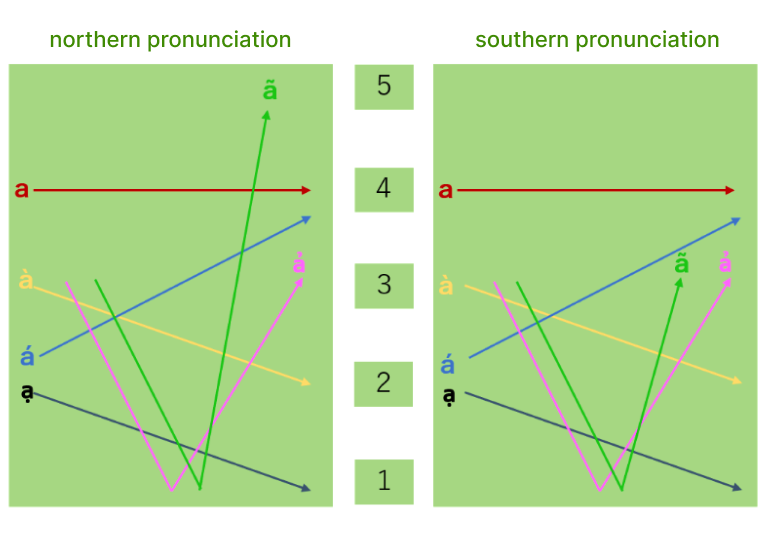Besides of 29 vowels and consonants present in Vietnamese that we introduced in the previous lesson, “tones” are a distinctive feature of the Vietnamese language. This lesson will focus on learning about Vietnamese tones.
What are Vietnamese tones?
Simply put, tones are variations in pitch. Vietnamese has six different tones, making it a tonal language. It is said that the abundance of tones makes learning Vietnamese challenging for speakers of non-tonal languages like Japanese.
How should tones be pronounced?
Pronunciation can vary by region within Vietnam, so to clarify, I have organized the tones into northern and southern categories in the following diagram.

In the diagram, the six Vietnamese tones (a à á ả ã ạ) are shown, with #1 being the lowest and #5 the highest. For example, the northern tone for ả is represented as 313, meaning the pitch starts at 3, drops to 1, and rises back to 3. The table below summarizes the six tones for both northern and southern accents.
| Tones | Explanation | Northern | Southern | Example | |
| 1 | ngang | Pronounce it somewhat high and flat | 44 | 44 |
hai |
| 2 | huyền | Pronounce it with a low voice, in a descending tone | 32 | 32 | hài(comedy) |
| 3 | sắc | Pronounce it with a normal voice pitch, in an ascending tone | 24 | 24 | hái (to pick – as in picking fruits) |
| 4 | hỏi | Pronounce it with a higher voice, lower it to the lowest point, then raise | 313 | 313 | hải sản (seafood) |
| 5 | ngã | Pronounce it with a higher voice, raise it while straining the throat in the middle, then raise | 315 | 313 | sợ hãi (fear) |
| 6 | nặng | With a lower voice, lower it while straining the throat, and press it out | 21 | 21 | hại (harm) |
At first glance, the vowels and tones might seem difficult, but in fact, mastering the pronunciation of Vietnamese can be achieved by remembering just these elements (vowels, consonants, and tones). This is because, unlike other languages, the pronunciation in Vietnamese does not change based on the word or context, making it actually a straightforward language to pronounce once learned.
However, even if vowels and consonants are pronounced correctly, using the wrong tone can completely change the meaning, so it’s important to also pronounce the tones correctly!
